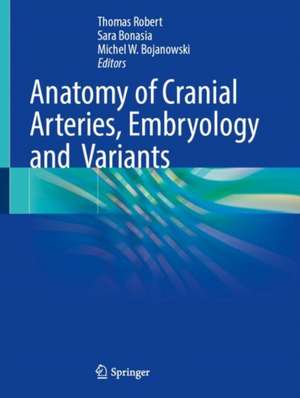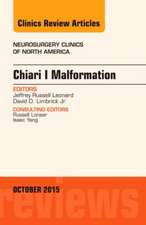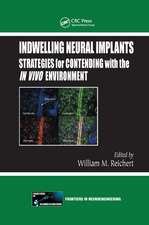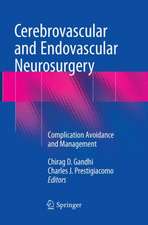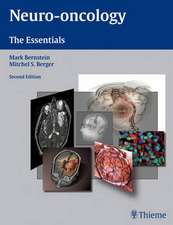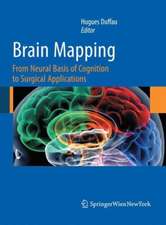Anatomy of Cranial Arteries, Embryology and Variants
Editat de Thomas Robert, Sara Bonasia, Michel W. Bojanowskien Limba Engleză Hardback – 2 oct 2023
The first section of the work is a reminder of general concepts of embryology. After that, each section corresponds to arteries of an anatomical location: intradural, dural, skull base and cranio-cervical junction. Each chapter is dedicated to a single artery to facilitate the reader’s search for information. In addition, modern and detailed illustrations of the embryological steps and adult variants are included. There are two types of illustrations: artist’s drawing, usually to explain the vascular embryology, and angiographic images.
The central point of the book lies in the space devoted to the embryological development of each artery and the processes that can lead to the development of different variants in the adult. The audience of this bookis aimed at neurosurgeons and neuroradiologists, specialists in the neurovascular area, but it will also help residents in neurosurgery, neuroradiology and neurology in their daily practice.
Preț: 1200.87 lei
Preț vechi: 1264.07 lei
-5% Nou
Puncte Express: 1801
Preț estimativ în valută:
229.84€ • 239.05$ • 192.61£
229.84€ • 239.05$ • 192.61£
Carte disponibilă
Livrare economică 20 februarie-06 martie
Preluare comenzi: 021 569.72.76
Specificații
ISBN-13: 9783031329128
ISBN-10: 3031329120
Pagini: 424
Ilustrații: XVI, 424 p. 317 illus., 292 illus. in color.
Dimensiuni: 210 x 279 mm
Greutate: 1.5 kg
Ediția:1st ed. 2023
Editura: Springer International Publishing
Colecția Springer
Locul publicării:Cham, Switzerland
ISBN-10: 3031329120
Pagini: 424
Ilustrații: XVI, 424 p. 317 illus., 292 illus. in color.
Dimensiuni: 210 x 279 mm
Greutate: 1.5 kg
Ediția:1st ed. 2023
Editura: Springer International Publishing
Colecția Springer
Locul publicării:Cham, Switzerland
Cuprins
Section I: General Concepts.-Chapter 1. A Brief Historical Review of Neurovascular Embryology.- Chapter 2. Embryological Development of the Human Cranio-Facial Arteries.- Section II: Intradural Arterial System.-Chapter 3. Embryological Development of the Internal Carotid Artery.- Chapter 4. Segmental Classifications of the Internal Carotid Artery.- Chapter 5. Branches and Variations of the Internal Carotid Artery.- Chapter 6. Segmental Agenesis of the Internal Carotid Artery.- Chapter 7. Embryology and Variations of the Anterior Choroidal Artery.- Chapter 8. Embryology, Anatomy, and Variations of the Anterior Cerebral Artery.- Chapter 9. Anatomy and Variations of the Anterior Communicating Artery.- Chapter 10. Embryology and Variations of the Recurrent Artery of Heubner.- Chapter 11. Embryology and Variations of the Posterior Choroidal Artery.- Chapter 12. Cortical and Perforating Branches of the Middle Cerebral Artery.- Chapter 13. Embryology and Anatomy of the Posterior Communicating Artery and Basilar .- Chapter 14. Embryology and Anatomy of the Posterior Cerebral Artery.- Chapter 15. Perforating Branches of the Posterior Cerebral Artery.- Chapter 16. Embryology and Anatomy of the Vertebral Artery.- Chapter 17. Anatomy and Variations of the Posterior Inferior Cerebellar Artery.- Chapter 18. Embryology and Variations of the Anterior Inferior Cerebellar Artery.- Chapter 19. Embryology and Variations of Superior Cerebellar Artery.- Chapter 20. Perforating Branches of the Basilar and Posterior Communicating Arteries.- Section III: Arterial System of the Dura and Supply of the Cranial Nerves.-Chapter 21. Anatomy, Embryology and Variations of the Middle Meningeal Artery.- Chapter 22. Dural Branches of the Internal Maxillary Artery.- Chapter 23. Dural Branches of the Internal Carotid Artery.- Chapter 24. Dural Branches of the Anterior and Posterior Cerebral Arteries.- Chapter 25. Dural Branches of the Ophthalmic Artery.- Chapter 26. Dural Branches of the Cerebellar Arteries.- Chapter 27. Dural Branches of the Vertebral Artery.- Chapter 28. Dural Branches of the Occipital Artery.- Chapter 29. Dural Branches of the Ascending Pharyngeal Artery.- Chapter 30. Arterial Supply of the Cranial Nerves .- Section IV: Arterial Systems of the Skull Base.-Chapter 31. Arterial Supply of the Middle Ear.- Chapter 32. Embryological Development of the Hyo-Stapedial System.- Chapter 33. Intra-Tympanic Flow of the Internal Carotid Artery.- Chapter 34. Embryology and Anatomy of the Internal Maxillary Artery.- Chapter 35. Embryology and Variations of the Ophthalmic Artery.- Chapter 36. Anatomy and Variations of the Superficial Temporal Artery.- Chapter 37. Embryology and Variations of the Occipital Artery.- Chapter 38. Embryology and Variations of the Ascending Pharyngeal Artery.- Chapter 39. Anatomy and Variations of the Posterior Auricular Artery.- Section V: Arterial Systems of the Cranio-Cervical Junction.-Chapter 40. Anastomotic network of the Cranio-Cervical Junction.- Chapter 41. Carotido-Vertebral Anastomoses.
Notă biografică
Dr. Thomas Robert, MD, is a Titular Professor of Neurological Surgery at the University of Southern Switzerland and a neurosurgeon in the private practice. He trained as neurosurgeon in Switzerland (Lausanne, Sion, Lugano), in France (Paris) and in Canada (Quebec, Montreal). After a strong knowledge about the general neurosurgery, he dedicated to the study of neurovascular diseases; in particular to cerebral aneurysms, brain arterio-venous malformations and dural arterio-venous fistulas. After the completion of distinct clinical fellowship, one in Interventional Neuroradiology at the Rothschild Foundation Hospital and the other in vascular and skull base Neurosurgery at the Centre Hospitalier Universitaire de Montreal (CHUM, Montreal, Quebec, Canada), he began his clinical practice at the Neurocenter of Southern Switzerland (Lugano, Switzerland). Since 2020, he holds the position of responsible for cranial neurosurgery and is also the resident’s program director in his department. In 2022 he moved to the clinical practice and continued his academic activity in the vascular field. Dr. Robert is fascinated by the embryology the cranio-facial arteries that allows to explain anatomical variations. His clinical research is mainly focused on vascular embryology, anatomical variations, and neurovascular diseases. He is the principal investigator of few national multicentric studies. He published nearly 65 publications and five educative books for residents and students in Neurosurgery. He also participated in the elaboration of various book chapters
Dr. Sara Bonasia, MD, is a Resident in Neurosurgery in Switzerland. She studied medicine at the Catholic University of Sacred Heart in Rome, obtaining her medical degree in 2017, and then moved to Switzerland (Lugano and then St. Gallen) to start her Neurosurgical Residency Program in 2018. She is actually completing her training with a Fellowship in Interventional Neuroradiology at the Rothschild Foundation Hospital in Paris. She was awarded the title of Medical Doctor in 2020 after writing a thesis entitled "Angiographic analysis of natural anastomoses between the anterior and posterior cerebral artery in Moyamoya disease and syndrome." Since this early work, her interest in vascular anatomy and embryology represents the main focus of her research and her scientific publications. Dr. Bonasia has always cultivated a keen interest in illustrative art, and from her earliest publications she demonstrated this passion by creating medical illustrations. Currently, she regularly contributes to scientific works by providing original illustrations with the aim of helping residents like herself to understand very complex concepts related to vascular anatomy. Since 2019, she has published approximately 15 scientific papers in the vascular field, of which she is first author on 10. The articles are mainly descriptive reviews related to cerebral arteries and their embryology, but also surgicalreports in the "How I do It" form as well as clinical studies. Since 2020 she is junior member of the Swiss Society of Neurosurgery, and of the Society of Swiss Young Neurosurgeons.
Prof. Michel W. Bojanowski, M.D., F.R.C.S.C., is a full professor in the Department of Surgery at the University of Montreal and neurosurgeon at University of Montreal Hospital Center(CHUM). Specialized in cerebrovascular disease and skull base tumors, professor Bojanowski is the director of the cerebrovascular section of the division of neurosurgery. A graduate in neurosurgery from the University of Montreal, he completed additional training in vascular neurosurgery at the Barrow Neurological Institute in Phoenix, Arizona. Professor Bojanowski has co-authored more than 150 publications in peer-reviewed journals and authored 15 book chapters. He has been a guest speaker on numerous occasions. For several years, he was responsible for teaching ethics to surgical residents at the University of Montreal, and has chaired the Medical Procedure Evaluation Committee of the Department of Surgery at CHUM. He is responsible for additional training (fellowship) in vascular neurosurgery and skull base at CHUM. He has won numerous teaching awards including the Senior Mentor Award from the University of Montreal Department of Surgery. Professor Bojanowski received the Quebec Medical Specialists Federation 2021 award for excellence in care for an innovative project.
Dr. Sara Bonasia, MD, is a Resident in Neurosurgery in Switzerland. She studied medicine at the Catholic University of Sacred Heart in Rome, obtaining her medical degree in 2017, and then moved to Switzerland (Lugano and then St. Gallen) to start her Neurosurgical Residency Program in 2018. She is actually completing her training with a Fellowship in Interventional Neuroradiology at the Rothschild Foundation Hospital in Paris. She was awarded the title of Medical Doctor in 2020 after writing a thesis entitled "Angiographic analysis of natural anastomoses between the anterior and posterior cerebral artery in Moyamoya disease and syndrome." Since this early work, her interest in vascular anatomy and embryology represents the main focus of her research and her scientific publications. Dr. Bonasia has always cultivated a keen interest in illustrative art, and from her earliest publications she demonstrated this passion by creating medical illustrations. Currently, she regularly contributes to scientific works by providing original illustrations with the aim of helping residents like herself to understand very complex concepts related to vascular anatomy. Since 2019, she has published approximately 15 scientific papers in the vascular field, of which she is first author on 10. The articles are mainly descriptive reviews related to cerebral arteries and their embryology, but also surgicalreports in the "How I do It" form as well as clinical studies. Since 2020 she is junior member of the Swiss Society of Neurosurgery, and of the Society of Swiss Young Neurosurgeons.
Prof. Michel W. Bojanowski, M.D., F.R.C.S.C., is a full professor in the Department of Surgery at the University of Montreal and neurosurgeon at University of Montreal Hospital Center(CHUM). Specialized in cerebrovascular disease and skull base tumors, professor Bojanowski is the director of the cerebrovascular section of the division of neurosurgery. A graduate in neurosurgery from the University of Montreal, he completed additional training in vascular neurosurgery at the Barrow Neurological Institute in Phoenix, Arizona. Professor Bojanowski has co-authored more than 150 publications in peer-reviewed journals and authored 15 book chapters. He has been a guest speaker on numerous occasions. For several years, he was responsible for teaching ethics to surgical residents at the University of Montreal, and has chaired the Medical Procedure Evaluation Committee of the Department of Surgery at CHUM. He is responsible for additional training (fellowship) in vascular neurosurgery and skull base at CHUM. He has won numerous teaching awards including the Senior Mentor Award from the University of Montreal Department of Surgery. Professor Bojanowski received the Quebec Medical Specialists Federation 2021 award for excellence in care for an innovative project.
Textul de pe ultima copertă
This book on the anatomy of central nervous system arteries concentrates on all anatomical variations of the central nervous system and it describes the embryological processes that hide behind the possible adult variants.
The first section of the work is a reminder of general concepts of embryology. After that, each section corresponds to arteries of an anatomical location: intradural, dural, skull base and cranio-cervical junction. Each chapter is dedicated to a single artery to facilitate the reader’s search for information. In addition, modern and detailed illustrations of the embryological steps and adult variants are included. There are two types of illustrations: artist’s drawing, usually to explain the vascular embryology, and angiographic images.
The central point of the book lies in the space devoted to the embryological development of each artery and the processes that can lead to the development of different variants in the adult. The audience of this book is aimed at neurosurgeons and neuroradiologists, specialists in the neurovascular area, but it will also help residents in neurosurgery, neuroradiology and neurology in their daily practice.
The first section of the work is a reminder of general concepts of embryology. After that, each section corresponds to arteries of an anatomical location: intradural, dural, skull base and cranio-cervical junction. Each chapter is dedicated to a single artery to facilitate the reader’s search for information. In addition, modern and detailed illustrations of the embryological steps and adult variants are included. There are two types of illustrations: artist’s drawing, usually to explain the vascular embryology, and angiographic images.
The central point of the book lies in the space devoted to the embryological development of each artery and the processes that can lead to the development of different variants in the adult. The audience of this book is aimed at neurosurgeons and neuroradiologists, specialists in the neurovascular area, but it will also help residents in neurosurgery, neuroradiology and neurology in their daily practice.
Caracteristici
Covers anatomy of central nervous system arteries Includes embryological processes Presents a high level of scientific quality
